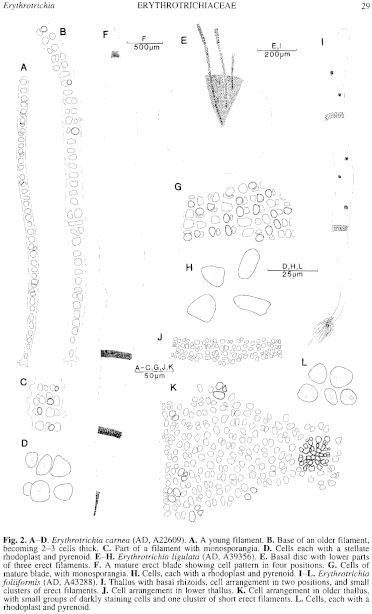|
|
|
|
|
|||||||||||
|
Electronic Flora of South Australia Species Fact Sheet
Phylum Rhodophyta – Class Bangiophyceae – Order Compsopogonales – Family Erythrotrichiaceae
Thallus (Fig. 2I) rose-red, erect, simple, ligulate with an elongate-cuneate base, monostromatic, with a rounded apex when young, truncated when older, margin smooth to undulate, blades becoming 4–8 mm long and 0.5–1.4 mm and 30–50 cells broad, 10–25 µm thick, attached by a mass of rhizoids arising from numerous supra-basal cells of the 2–6 cells broad base of the thallus. Cells more or less in transverse and longitudinal rows near the base (Fig. 2J), soon becoming irregularly arranged (Fig. 2K) but with marginal cells in a fairly regular row. Cell divisions diffuse throughout the blade, cells round to ovoid in surface view and in section, (8–) 10–16 µm across, with scattered larger cells; rhodoplasts (Fig. 2L) more or less stellate, each with a pyrenoid.
Reproduction: Reproduction uncertain. Larger thallus cells may act as monospores, produced after cell division but probably not from a "differentiated" monosporangium. Some thallus cells (Fig. 2K) divide into two, then into four, and such groups often produce a cluster (Fig. 2K) 40–80 µm across of erect filaments 20–30 µm and a few cells long; occasional cells of these erect filaments divide further into small spermatangia-like groups.
Type from Kaikoura, New Zealand, in Herb. South (2115), NFLD?
Distribution: Wellington and Kaikoura districts, New Zealand (on Marginariella boryana, Lessonia variegata and Macrocystis pyrifera).
In southern Australia, known from Clyde I., Eaglehawk Neck, Tas., on Lessonia corrugata (Ducker, 1.xi.1963; MELU, 966; AD, A43288).
Taxonomic notes: The Tasmanian material agrees well with the New Zealand plants, but whether it should be placed in Erythrotrichia is doubtful. The basal rhizoids [also in E. vexillaris (Montagne) Hamel (Taylor 1942, p. 77, pl. 1 figs 2–11)] and monospores doubtfully formed from differentiated sporangia separate it from other species of this genus. However, it is left in Erythrotrichia pending a study of its reproduction.
References:
SOUTH, G.R. & ADAMS, N.M. (1976). Erythrotrichia foliiformis sp. nov. (Rhodophyta, Erythropeltidaceae) from New Zealand. J. Roy. Soc. N.Z. 6, 399–405.
TAYLOR, W.R. (1942). Caribbean marine algae of the Allan Hancock Expedition, 1939. Allan Hancock Atlantic Expedition No. 2, 1–193.
The Marine Benthic Flora of Southern Australia Part IIIA complete list of references.
Publication:
Womersley, H.B.S. (14 January, 1994)
The Marine Benthic Flora of Southern Australia
Rhodophyta. Part IIIA, Bangiophyceae and Florideophyceae (to Gigartinales)
Reproduced with permission from The Marine Benthic Flora of Southern Australia Part IIIA 1994, by H.B.S. Womersley. Australian Biological Resources Study, Canberra. Copyright Commonwealth of Australia.
Illustration in Womersley Part IIIA, 1994: FIG. 2 I–L.

Figure 2 enlarge
Fig. 2. A–D. Erythrotrichia carnea (AD, A22609). A. A young filament. B. Base of an older filament, becoming 2-3 cells thick. C. Part of a filament with monosporangia. D. Cells each with a stellate rhodoplast and pyrenoid. E–H. Erythrotrichia ligulata (AD, A39356). E. Basal disc with lower parts of three erect filaments. F. A mature erect blade showing cell pattern in four positions. G. Cells of mature blade, with monosporangia. H. Cells, each with a rhodoplast and pyrenoid. I–L. Erythrotrichia foliiformis (AD, A43288). I. Thallus with basal rhizoids, cell arrangement in two positions, and small clusters of erect filaments. J. Cell arrangement in lower thallus. K. Cell arrangement in older thallus, with small groups of darkly staining cells and one cluster of short erect filaments. L. Cells, each with a rhodoplast and pyrenoid.

|
Email Contact: State Herbarium of South Australia |

|